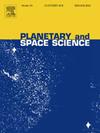Secondary electron generation by sub-keV ion and energetic neutral particle impacts on a surface
IF 1.7
4区 物理与天体物理
Q3 ASTRONOMY & ASTROPHYSICS
引用次数: 0
Abstract
The secondary electron yield (SEY) from sub-keV ion and neutral particle impacts on a stainless steel surface has been investigated in the laboratory. Sub-keV ions were generated using a large Kauffman ion source and energetic neutral particles (ENPs) were generated from ion-neutral charge-exchange collisions. It is found that the SEY from ion impacts increases with the ion kinetic energy, reaching the yield of 0.25-0.4 by the 1000 eV ion impact, depending on the surface cleanliness. The SEY from neutral impacts is about an order of magnitude lower than from ion impacts, indicating that the electrostatic potential energy plays a bigger role in generating secondary electrons than the kinetic energy in this energy range. It is shown that the SEY is higher for impacts by lighter ion species. The effect of surface cleanliness is investigated, showing an increase in the SEY for a contaminated surface. Our results show that secondary electrons generated from sub-keV ion impacts are non-negligible and may play a more pronounced role in determining the surface charge in various space environments, such as permanently shadowed regions (PSRs) on airless bodies. The SEY measured from sub-keV ENP impacts is useful for determining the surface charge of a spacecraft moving through dense planetary atmospheres.
亚电子离子和高能中性粒子撞击表面产生的二次电子
在实验室研究了亚电子离子和中性粒子对不锈钢表面的二次电子产率。亚键离子采用大型考夫曼离子源产生,高能中性粒子(ENPs)由离子中性电荷交换碰撞产生。研究发现,随着离子动能的增加,离子撞击产生的SEY增加,根据表面清洁度的不同,1000 eV离子撞击产生的产率达到~ 0.25-0.4。中性撞击产生的SEY比离子撞击产生的SEY低一个数量级左右,说明在该能量范围内,静电势能比动能对产生二次电子的作用更大。结果表明,较轻的离子种类对土壤的影响更大。研究了表面清洁度的影响,表明污染表面的SEY增加。我们的研究结果表明,由亚键离子撞击产生的二次电子是不可忽略的,并且可能在确定各种空间环境中的表面电荷方面发挥更明显的作用,例如在无空气的物体上的永久阴影区域(PSRs)。从亚kev ENP撞击中测量的SEY对于确定在密集的行星大气中移动的航天器的表面电荷是有用的。
本文章由计算机程序翻译,如有差异,请以英文原文为准。
求助全文
约1分钟内获得全文
求助全文
来源期刊

Planetary and Space Science
地学天文-天文与天体物理
CiteScore
5.40
自引率
4.20%
发文量
126
审稿时长
15 weeks
期刊介绍:
Planetary and Space Science publishes original articles as well as short communications (letters). Ground-based and space-borne instrumentation and laboratory simulation of solar system processes are included. The following fields of planetary and solar system research are covered:
• Celestial mechanics, including dynamical evolution of the solar system, gravitational captures and resonances, relativistic effects, tracking and dynamics
• Cosmochemistry and origin, including all aspects of the formation and initial physical and chemical evolution of the solar system
• Terrestrial planets and satellites, including the physics of the interiors, geology and morphology of the surfaces, tectonics, mineralogy and dating
• Outer planets and satellites, including formation and evolution, remote sensing at all wavelengths and in situ measurements
• Planetary atmospheres, including formation and evolution, circulation and meteorology, boundary layers, remote sensing and laboratory simulation
• Planetary magnetospheres and ionospheres, including origin of magnetic fields, magnetospheric plasma and radiation belts, and their interaction with the sun, the solar wind and satellites
• Small bodies, dust and rings, including asteroids, comets and zodiacal light and their interaction with the solar radiation and the solar wind
• Exobiology, including origin of life, detection of planetary ecosystems and pre-biological phenomena in the solar system and laboratory simulations
• Extrasolar systems, including the detection and/or the detectability of exoplanets and planetary systems, their formation and evolution, the physical and chemical properties of the exoplanets
• History of planetary and space research
 求助内容:
求助内容: 应助结果提醒方式:
应助结果提醒方式:


